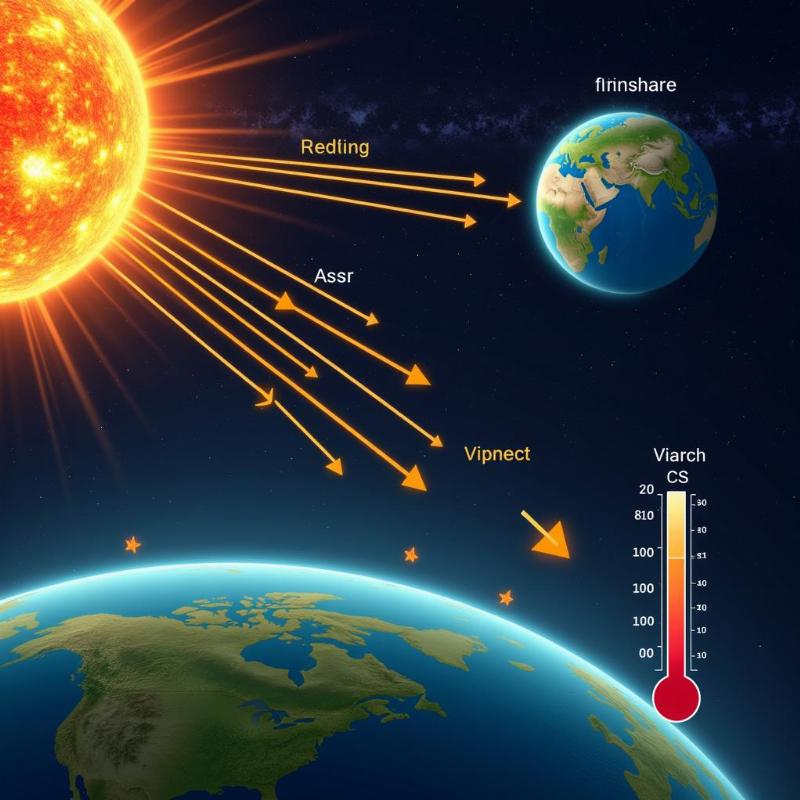Heat travels through a vacuum by radiation, a process that involves electromagnetic waves. Unlike conduction and convection, radiation doesn’t require a medium to transfer thermal energy. This means heat can travel through the emptiness of space, which is how we receive warmth from the sun. Understanding this fundamental principle is key to grasping various phenomena, from the workings of a thermos flask to the temperature balance of our planet.
How Does Radiation Transfer Heat Through a Vacuum?
Radiation is the emission of energy as electromagnetic waves. These waves, including infrared radiation which we perceive as heat, can travel through a vacuum at the speed of light. When these waves encounter an object, they are absorbed, causing the object’s internal energy and temperature to increase. Think of the sun: it emits radiation across the vast vacuum of space, and this radiation warms the Earth. Similarly, a hot object in a vacuum will radiate heat outwards, cooling itself in the process.
 Heat Transfer in Vacuum via Radiation
Heat Transfer in Vacuum via Radiation
Why Can’t Conduction and Convection Occur in a Vacuum?
Conduction and convection rely on the presence of matter. Conduction involves the transfer of heat through direct contact between particles. When one end of a metal rod is heated, the particles in that area vibrate more vigorously, bumping into their neighbors and transferring the energy along the rod. Convection, on the other hand, relies on the movement of fluids (liquids or gases). Heated fluid becomes less dense and rises, while cooler, denser fluid sinks, creating a circulation that transfers heat. Since a vacuum is devoid of matter, neither conduction nor convection can occur.
Everyday Examples of Heat Transfer Through Vacuum by Radiation
The principle of heat transfer through vacuum by radiation is evident in many everyday objects and phenomena. Thermos flasks, designed to keep liquids hot or cold, utilize a vacuum between their inner and outer walls to minimize heat transfer by conduction and convection. The shiny inner surface reflects radiation back into the liquid, further minimizing heat loss. Satellite temperature control in space also relies on manipulating radiation. Satellites are coated with special materials to reflect sunlight and prevent overheating, while internal heaters powered by solar panels provide warmth when needed.
What are the Different Types of Electromagnetic Radiation Involved in Heat Transfer?
While infrared radiation is the primary form of electromagnetic radiation associated with heat transfer, other types also play a role. These include visible light, ultraviolet radiation, and microwaves. The amount of heat carried by each type of radiation depends on its wavelength and frequency. For instance, ultraviolet radiation from the sun can cause sunburn, demonstrating its ability to transfer significant energy.
How is Heat Transfer by Radiation Different in a Vacuum Compared to a Medium?
In a medium like air or water, radiation still occurs, but it’s often accompanied by conduction and convection. The presence of the medium can affect the rate of heat transfer. For example, air can absorb and scatter some of the radiation, slowing down the overall heat transfer process. In a vacuum, radiation is the sole mechanism of heat transfer, and it occurs unimpeded. This makes it a highly efficient method of heat transfer in the absence of matter.
Dr. Anya Sharma, Astrophysicist at the Indian Institute of Astrophysics, states, “Understanding radiation is crucial for comprehending the energy balance of stars and planets. It’s the fundamental way heat travels through the vast emptiness of space, shaping the universe as we know it.”
Conclusion
Heat travels through vacuum by radiation, a process involving electromagnetic waves, primarily infrared radiation. Unlike conduction and convection, which require a medium, radiation can transfer thermal energy across the emptiness of space. This explains how we receive warmth from the sun and is a fundamental principle governing various phenomena, from the design of thermos flasks to the temperature control of satellites. Understanding this concept provides valuable insights into the workings of our universe.
FAQ
-
How does heat travel through empty space? Heat travels through empty space by radiation, the emission of energy as electromagnetic waves.
-
Why can’t conduction or convection work in a vacuum? Both conduction and convection need a medium (matter) to transfer heat, which a vacuum lacks.
-
What is the main type of radiation responsible for heat transfer? Infrared radiation is primarily responsible for heat transfer.
-
How does a thermos flask utilize the principle of radiation? A thermos flask uses a vacuum between its walls to prevent conduction and convection. The reflective inner surface minimizes heat loss by radiation.
-
Is radiation the only way heat travels in a vacuum? Yes, radiation is the sole method of heat transfer in a vacuum.
Plan your next adventure with PlaToVi! We offer a range of services, including curated tour packages, hotel and resort bookings, international and domestic flight reservations, event planning, car rentals, and visa assistance. Discover the wonders of India and beyond with us. Contact us today at [email protected] or call us at +91 22-2517-3581. Let PlaToVi** be your trusted travel companion!